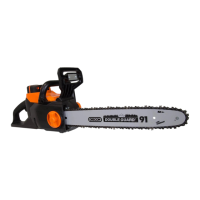OPERATION
20
Log Supported on Both Ends
2
nd
cut overbuck (Ø ²/3) to meet 1
st
cut (to avoid pinching)
1st cut underbuck (Ø ¹/3) to
avoid splintering
Tree Limbing
Limb
Cut
When the log is supported on both ends (Fig. 14),
cut 1/3 the diameter from the top (overbuck). Then
make the finished cut by underbucking the lower
2/3 to meet the first cut.
When bucking on a slope always stand on the up-
hill side of the log (Fig. 15). When cutting through,
to maintain complete control, release the cutting
pressure near the end of the cut without relaxing
your grip on the chain saw handles. Don’t let the
chain contact the ground. After completing the cut,
wait for the saw chain to stop before you move the
chain saw. Always stop the motor before moving
from tree to tree.
LIMBING A TREE
Limbing is removing the branches from a fallen
tree. When limbing leave larger lower limbs to
support the log off the ground. Remove the small
limbs in one cut (Fig. 16). Branches under tension
should be cut from the bottom up to avoid binding
the chain saw.
SAWING TECHNIQUES
Saw off the lower branches on the tree first. By do-
ing so, it is easier for the cut branches to fall to the
ground.
At the end of the cut, the weight of the saw sud-
denly increases for the user since it is no longer
being supported by a branch. There is a risk of los-
ing control of the saw, so make sure to stay alert
during the entire sawing operation.
Only pull the saw out of a cut while the saw is run-
ning. By doing so, you prevent the chain from jam-
ming in the wood.
Fig. 14
Bucking a Log
Stand on uphill side while cutting
because the log may roll.
Leave support limbs to keep work off the ground.
Fig. 15
Fig. 16
Do not saw with the tip of the guide bar. Do not saw into the branch formations (where the tree branch-
es outwards). This will impede the tree’s ability to heal.
For sawing off smaller branches, place the stop face of the saw on the branch. This prevents unwanted
movements of the saw at the beginning of the cut. While applying light pressure, guide the saw through
the branch from top to bottom.
For sawing off larger branches, first make a relief cut. Saw through 1/3 of the branch diameter from
the bottom to top using the top side of the guide bar. Then saw from top to bottom for the other 2/3
using the bottom side of the guide bar. Saw off longer branches in sections in order to maintain control
over the location of impact.

